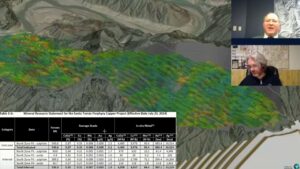VANCOUVER, BRITISH COLUMBIA–(Marketwire – Nov. 21, 2012) – Timmins Gold Corp. (“Timmins Gold” or the “Company”) (TSX:TMM)(NYSE MKT:TGD)(NYSE Amex:TGD) announces a summary of the results from a recent bulk sample locked column leach testing program on material from the Company’s San Francisco Mine (San Francisco deposit and La Chicharra deposit) and tested at METCON Research metallurgical laboratory in Tucson, Arizona in 2012.
The column testing results indicate an average gold extraction of 71.0% based on a crush size of 80% of the particles passing 3/8 inch (P80 3/8 inch) and 77.1% based on a crush size of 80% of the particles passing 1/4 inch (P80 1/4 inch) on ore samples from the San Francisco deposit. For La Chicharra ore samples, the column testing results indicate an average gold extraction of 78.3% and 80.9% based on a crush size of P80 3/8 inch and a crush size of P80 1/4 inch, respectively. No percolation issues were observed in the locked cycle tests.
Bruce Bragagnolo, CEO of Timmins Gold, stated, “We are encouraged by the metallurgical results from this recent metallurgical testing program. We will continue to use a Life of Mine (LOM) recovery of 68.6% gold recovery in our planning and analyses, based on our most recent mine plan and block model. We believe however that the results of this testing program indicate there is potential to further improve our recoveries through process optimization.”
Discussion of Test Results
Six composite samples were tested in the current metallurgical study; five from the San Francisco (SF) deposit and one from La Chicharra. The samples from the San Francisco deposit varied by rock type.
- La Chicharra
- SF – Granite
- SF – Basic Gneiss
- SF – Gabbro
- SF – Pegmatite & Schist
- SF – Acid Gneiss
Tables 1 and 2 outline the gold extractions for each sample based on crush sizes of P80 3/8 inch (9.5mm) and P80 1/4 inch (6.3mm), respectively. Two averages are shown: (1) a simple average and (2) a weighted average based on the estimated LOM relative abundance of each rock type within the deposit.
| Table 1 – Summary of column leach tests, P80 -3/8″ crush size, 127 days. | ||
| LOM Abundance | Au Extraction (%) | |
| SF – Granite | 13.0% | 76.58 |
| SF – Basic Gneiss | 26.4% | 71.08 |
| SF – Gabbro | 18.9% | 63.78 |
| SF – Pegmatite & Schist | 12.7% | 74.38 |
| SF – Acid Gneiss | 29.1% | 71.40 |
| SF – Simple Avg. | 100% | 71.44 |
| SF – Weighted Avg. | ||
| (based on LOM abundance) | 100% | 71.00 |
| La Chicharra | 100% | 78.34 |
| Table 2 – Summary of column leach tests, P80 -1/4″ crush size, 127 days. | ||
| LOM Abundance | Au Extraction (%) | |
| SF – Granite | 13.0% | 87.89 |
| SF – Basic Gneiss | 26.4% | 74.37 |
| SF – Gabbro | 18.9% | 71.22 |
| SF – Pegmatite & Schist | 12.7% | 79.69 |
| SF – Acid Gneiss | 29.1% | 77.03 |
| SF – Simple Avg. | 100% | 78.04 |
| SF – Weighted Avg. | ||
| (based on LOM abundance) | 100% | 77.06 |
| La Chicharra | 100% | 80.89 |
The common leaching parameters to all column leach tests are summarized below:
- Sample sizes were ~178kg for each column test.
- Calcium oxide was blended into the test charge. Calcium oxide consumption was determined in a 72 hr agitated cyanidation bottle roll test.
- The initial feed solution was prepared by adding reagent grade calcium oxide to Tucson tap water to obtain a solution pH of 11.00, followed by the addition of 1.0 gram of sodium cyanide per liter of solution. The columns were irrigated at a flow rate of 10 liters per hour per square meter.
- Column tests were conducted under locked cycle type of leaching regime by contacting the pregnant solution with activated carbon to remove gold and silver in solution. The loaded activated carbon in each column test was dried, weighed and saved in sealed and labeled plastic bags.
- The resulting barren solution was used as feed solution after the addition of sodium cyanide and calcium oxide to maintain 1.0 gram of cyanide per liter of solution and a pH of 10.50 to 11.00.
Quality Control
As part of the METCON QA/QC program, approximately 10 percent of the daily pregnant solution samples from each column test were re-assayed to verify accuracy of the original gold and silver assay conducted on the daily pregnant solution samples. Linear regression analysis was conducted to quantify the difference between both assays. The following table summarizes the QA/QC analysis conducted on the pregnant solution samples.
| Table 3 – Correlation coefficient, Daily pregnant solution vs. Duplicates | ||
| R2 Correlation Coefficient | ||
| Au | Ag | |
| SF – Granite | 0.9596 | 0.9539 |
| SF – Basic Gneiss | 0.9563 | 0.9445 |
| SF – Gabbro | 0.9842 | 0.9729 |
| SF – Pegmatite & Schist | 0.9808 | 0.9738 |
| SF – Acid Gneiss | 0.9277 | 0.9086 |
| La Chicharra | 0.9696 | 0.9970 |
The linear regression analysis conducted on the pregnant solution assays showed that there is a good correlation between the original gold and silver assays and the duplicate assays conducted as part of the METCON QA/QC program.
About Timmins Gold
Focused solely in Mexico, Timmins Gold Corp. is in commercial gold production at its wholly owned San Francisco gold mine in Sonora, Mexico. The mine is a past-producing open pit heap leach operation. Timmins Gold has forecast production at a rate of approximately 130,000 ounces of gold per year (Micon International NI 43-101F1 Technical Report dated November, 2011).
This press release was reviewed and prepared by Lawrence A. Dick, Ph.D., P.Geo, who is a consultant to the Company and is recognized as a Qualified Person under the guidelines of National Instrument 43-101 (“QP”) and by Miguel Soto, P. Geo., a director and the Vice President of Operations of the Company and by Rodrigo R. Carneiro, MS., QP in Metallurgy and Processing, Director of Metcon Research and Process Engineering of Tucson Arizona. For further information contact Timmins Gold Corp. at 604-682-4002 or go to the website at www.timminsgold.com.
Cautionary Note Regarding Forward-Looking Statements
Certain statements contained herein may constitute forward-looking statements and are made pursuant to the “safe harbor” provisions of the United States Private Securities Litigation Reform Act of 1995 and Canadian securities laws. Forward-looking statements are statements which relate to future events. Such statements include estimates, forecasts and statements as to management’s expectations with respect to, among other things, business and financial prospects, financial multiples and accretion estimates, future trends, plans, strategies, objectives and expectations, including with respect to production, exploration drilling, reserves and resources, exploitation activities and events or future operations. Information inferred from the interpretation of drilling results and information concerning mineral resource estimates may also be deemed to be forward-looking statements, as it constitutes a prediction of what might be found to be present when, and if, a project is actually developed.
In some cases, you can identify forward-looking statements by terminology such as “may”, “should”, “expects”, “plans, “anticipates”, believes”, “estimates”, “predicts”, “potential”, or “continue” or the negative of these terms or other comparable terminology. These statements are only predictions and involve known and unknown risks, uncertainties and other factors that may cause our or our industry’s actual results, level of activity, performance or achievements to be materially different from any future results, levels of activity, performance, or achievements expressed or implied by these forward-looking statements.
While these forward-looking statements, and any assumptions upon which they are based, are made in good faith and reflect our current judgment regarding the direction of our business, actual results will almost always vary, sometimes materially, from any estimates, predictions, projections, assumptions or other future performance suggestions herein.
Except as required by applicable law, Timmins Gold does not intend to update any forward-looking statements to conform these statements to actual results.
Neither the TSX nor its Regulation Services Provider (as that term is defined in the policies of the TSX) nor the NYSE MKT accepts responsibility for the adequacy or accuracy of this news release.
Contact Information
- Timmins Gold Corp.
Bruce Bragagnolo
CEO and Director
604-638-8980
bruce@timminsgold.com
www.timminsgold.com
















